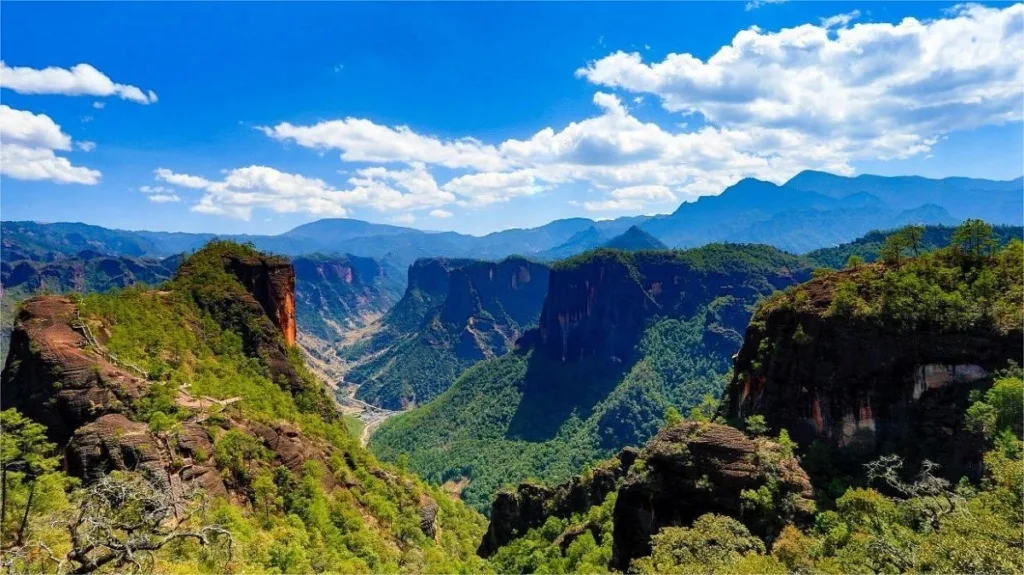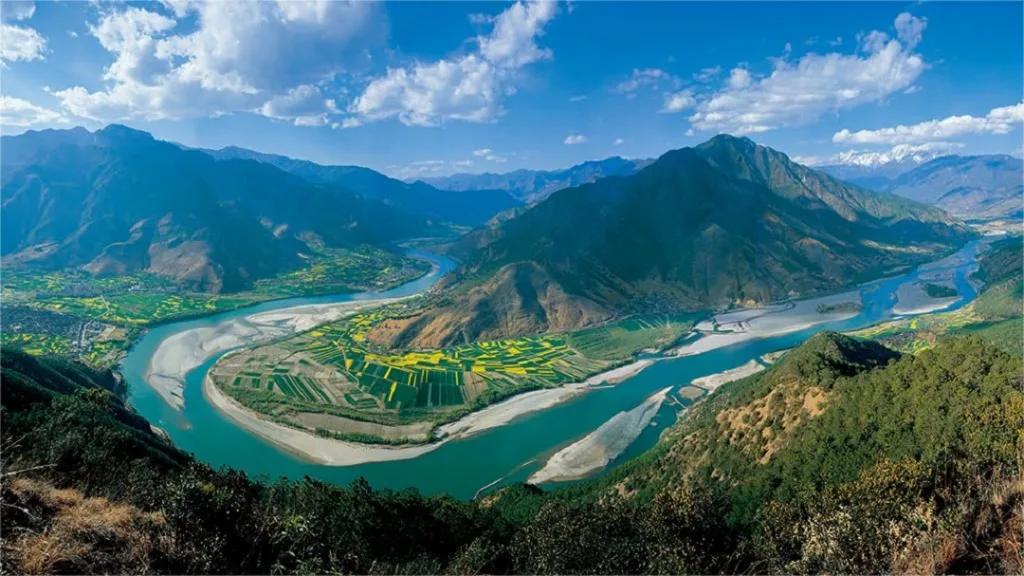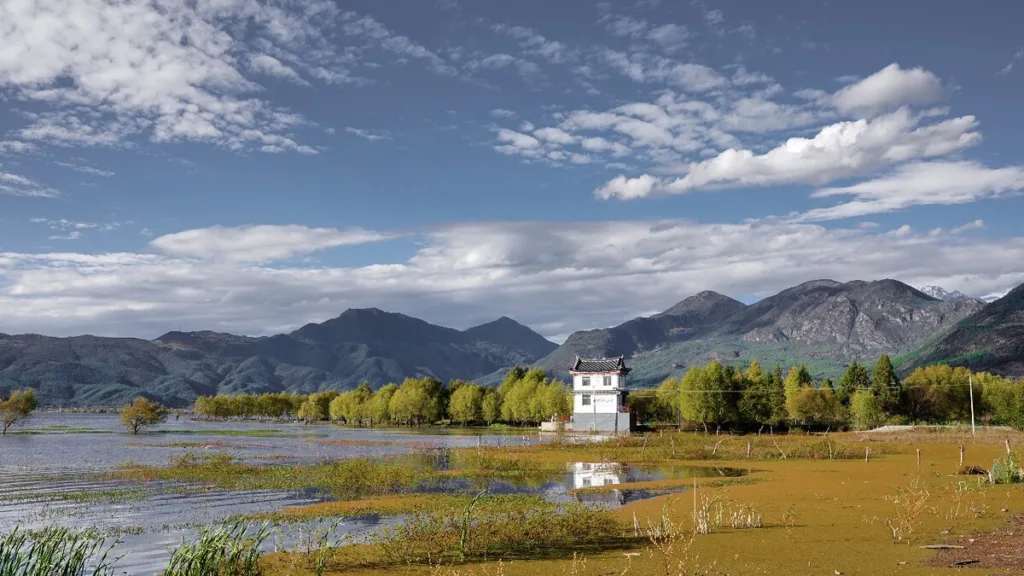Zhiyun Temple (指云寺), also known as “Garma Namgyal Ling” in Tibetan, meaning “Garden of Victory,” is the ancestral residence of successive Dongbao Zhambhala Tulkus and the main temple of the Northwest Dianxi Gaju sect (White Sect). It’s also the headquarters of the Buddhist Association of Yulong County. Established in the fifth year of the Yongzheng reign of the Qing Dynasty (1727), it’s one of the five major temples in Lijiang. The temple originally consisted of 13 courtyards but now retains only one large courtyard and five small ones.
Legend has it that a man named Li Xiang from Shuhe, Lijiang, made a living by making bamboo crafts before becoming a monk at Fuguo Temple. One year, when the Tibetan Dzogchen Rinpoche visited Lijiang, he summoned all the monks for assessment. Impressed by Li Xiang’s proficiency, the Rinpoche took him to Tibet for further Buddhist studies. After completing his studies, Li Xiang returned to Lijiang to propagate Buddhism. When choosing a location to build the temple, it is said that a mysterious figure pointed to a patch of colorful clouds in the western sky and said, “This is where the temple should be built.” Following this guidance, Li Xiangyuan built the temple beneath the clouds and named it Zhiyun Temple, where Zhiyun means pointing at the clouds.
Table of Contents
- Basic Information
- Location and Transportation
- Highlights of Zhiyun Temple
- Vlog about Zhiyun Temple
- Other Attractions in Lijiang Suburbs
Basic Information
| Estimated Length of Tour | 1 – 2 hours |
| Ticket Price | Free |
| Opening Hours | 8.00 – 21.00 |
Location and Transportation
Zhiyun Temple is located in Lashi Town, Yulong Naxi Autonomous County, Lijiang City, Yunnan Province, China. It is approximately 18 kilometers away from the Lijiang Ancient Town.
If you have enough time, you can ride a bike from Lijiang Ancient Town to Zhiyun Temple, which takes about an hour and a half. Along the way, you can visit Lashi Lake. Alternatively, you can hire a car, which costs around 30 yuan, or take Bus Route 31 and get off Zhiyun Temple Stop.
Highlights of Zhiyun Temple
Main Hall

The spacious main hall of Zhiyun Temple can accommodate over a hundred lamas for rituals and hundreds of monks for chanting. It is distinguished among Lijiang’s thirteen major temples by having the most pillars and the largest area. With a height of over 13 meters, the hall’s facade spans seven bays and is 12.85 meters long. The exquisite carvings on the doors and windows demonstrate exceptional craftsmanship, making it a masterpiece among Lijiang’s ancient buildings. In the center of the hall, there is a statue of Shakyamuni Buddha, flanked by several other statues. On the left side, there is a stupa for the fifteenth Dongbao Living Buddha. At the center of the temple courtyard, there is a large incense burner made of colorful stones, with its sandalwood holders inlaid with gold. It is regularly polished by incense attendants, giving it a shining appearance, making it a rare treasure.
Living Buddha’s Quarters

One room to the west serves as the quarters for the fifteenth and sixteenth Dongbao Living Buddhas. Inside, there is a wooden bed and a two-tiered wooden cabinet, containing various sacred artifacts. These include a small bronze seal belonging to the fifteenth Living Buddha, a Qianlong-era seal ink box, a fifth-rank tiger-shaped seal, a pair of ivory chopsticks used by a previous Living Buddha, and a jade snuff bottle. These items are kept in a leather bag wrapped in red cloth for preservation. On top of the cabinet lies a double-layered gilded hat, given to the fourteenth Living Buddha by the Dzogchen Rinpoche. The lower tier of the cabinet contains clothing worn for rituals, including a yellow silk robe worn by the fifteenth Living Buddha, which was brought back from Gengzi Babang Temple in Dege, Garze, where it was preserved by the sixteenth Living Buddha. The central chamber serves as a reception room, housing a statue of Shakyamuni Buddha carved from Han white marble, while the upper floor contains many more Buddha statues.
Buddhist Relics

Zhiyun Temple’s upper floor above the second gatehouse houses a collection of ritual tools, including masks and robes used in Cham dances (ritual dances), with the most precious items being Tangka paintings and Buddha images. According to Chen Tongshi, an official at Dege Babang Temple, these Tangka paintings and the Buddha images by Maxiao Xian were gifted to the fifteenth Dongbao Living Buddha by Babang Temple after he acted as the regent for the fourth Babang Living Buddha. Maxiao Xian was a painter brought from Ningbo, Zhejiang, during the Ming Dynasty by the local Mu clan chieftains. When the Great Babang Living Buddha visited Lijiang and admired Maxiao Xian’s murals, he appreciated his talent and brought him to Tibet, where he later went to India.






